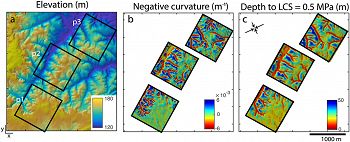Moon et al., 2017
A model of three-dimensional topographic stresses with implications for bedrock fractures, surface processes, and landscape evolution
Moon, S., J.T. Perron, S.J. Martel, W.S. Holbrook, and J. St. Clair (2017)
Journal of Geophysical Research: Earth Surface 122 (4): 823-846 Cross-CZO
-
Boulder, Calhoun, COLLABORATOR
-
Boulder, Calhoun, Eel, Reynolds, Sierra, COLLABORATOR
Abstract
Figure 9. Maps of the Calhoun site showing (a) elevation, (b) mean negative curvature calculated from a smoothed topographic surface, and (c) the depth to a least compressive stress of 0.5 MPa (DLCS) calculated with tectonic stress conditions of math formula = 6.25 MPa, math formula = 4 MPa with H oriented N65°E.
Bedrock fractures influence the rates of surface processes that drive landscape evolution and are in turn influenced by landforms that perturb ambient tectonic and gravitational stress fields. In this modeling study, we examine how three-dimensional topography and tectonic stress regimes influence elastic stress fields and bedrock fracture patterns beneath Earth's surface. We illustrate general effects of landform orientation and of tectonic stress magnitude and anisotropy using boundary element models of stresses beneath synthetic elongated ridges with different aspect ratios. We then examine the more detailed effects of landform shape using natural landscapes in Colorado and South Carolina. We show that the stress field is most sensitive to topographic perturbations if the most compressive horizontal tectonic stress is oriented perpendicular to the long axis of elongated landforms such as ridges and valleys and that topographic stress perturbations are most pronounced beneath landforms with higher mean curvatures, such as channel junctions and ridge crests. The shape of a predicted fracture-rich zone in the subsurface depends mainly on the orientation of landforms relative to the most compressive horizontal tectonic stress direction and a dimensionless ratio that expresses the relative magnitudes of topographic stresses associated with horizontal tectonic compression and topographic relief. Variations in this dimensionless ratio can also change the predicted orientations of potential opening-mode fracture planes. We use these model results to illustrate how topographic perturbations of three-dimensional tectonic and gravitational stresses could influence landscape evolution by altering the rates and spatial heterogeneity of surface processes and groundwater flow.
Citation
Moon, S., J.T. Perron, S.J. Martel, W.S. Holbrook, and J. St. Clair (2017): A model of three-dimensional topographic stresses with implications for bedrock fractures, surface processes, and landscape evolution. Journal of Geophysical Research: Earth Surface 122 (4): 823-846. DOI: 10.1002/2016JF004155
Explore Further



